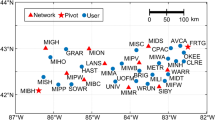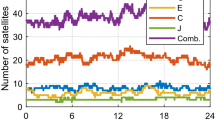Abstract
A synthesis of two prevailing global navigation satellite system positioning technologies, namely the precise point positioning and the network-based real-time kinematic, results in the emergence of the PPP-RTK, enabling single-receiver users to achieve high positioning accuracy with reasonable timeliness through integer ambiguity resolution. The realization of PPP-RTK needs to accomplish two sequential tasks. The first task is to determine a class of corrections including, among others, the satellite phase biases (SPBs) at the network level. With these corrections, the second task, then, is to solve for the ambiguity-fixed, absolute position at the user level. In this contribution, we revisit three variants (geometry-free, geometry-fixed and geometry-plus-satellite-clock-fixed) of the undifferenced and uncombined PPP-RTK network model and then point out their implications for practical use. We also carry out a case study using multi-day, dual-frequency global positioning system data from the crustal movement observation network of China stations, aiming to figure out what are the most appropriate linear combinations of the SPBs to be transmitted to the users from the viewpoint of decorrelation, and to assess the static and kinematic positioning performance.









Similar content being viewed by others
References
Arnold D et al (2015) CODE’s new solar radiation pressure model for GNSS orbit determination. J Geod 89(8):775–791
Bertiger W, Desai SD, Haines B, Harvey N, Moore AW, Owen S, Weiss JP (2010) Single receiver phase ambiguity resolution with GPS data. J Geod 84(5):327–337
Collins P, Bisnath S, Lahaye F, Héroux P (2010) Undifferenced GPS ambiguity resolution using the decoupled clock model and ambiguity datum fixing. Navigation 57(2):123–135
Dow JM, Neilan RE, Rizos C (2009) The international GNSS service in a changing landscape of global navigation satellite systems. J Geod 83(3–4):191–198
Gao Y, Shen X (2002) A new method for carrier-phase-based precise point positioning. Navigation 49(2):109–116
Ge M, Gendt G, Ma Rothacher, Shi C, Liu J (2008) Resolution of GPS carrier-phase ambiguities in precise point positioning (PPP) with daily observations. J Geod 82(7):389–399
Geng J, Teferle FN, Meng X, Dodson A (2011) Towards PPP-RTK: ambiguity resolution in real-time precise point positioning. Adv Space Res 47(10):1664–1673
Geng J, Shi C, Ge M, Dodson AH, Lou Y, Zhao Q, Liu J (2012) Improving the estimation of fractional-cycle biases for ambiguity resolution in precise point positioning. J Geod 86(8):579–589
Hofmann-Wellenhof B, Lichtenegger H, Wasle E (2008) GNSS–Global Navigation Satellite Systems: GPS, GLONASS, Galileo & more. Springer, New York
Khodabandeh A, Teunissen P (2014) Array-based satellite phase bias sensing: theory and GPS/BeiDou/QZSS results. Meas Sci Technol 25(9):095801
Khodabandeh A, Teunissen P (2015) An analytical study of PPP-RTK corrections: precision, correlation and user-impact. J Geod 89(11):1109–1132
Khodabandeh A, Teunissen P (2016) PPP-RTK and inter-system biases: the ISB look-up table as a means to support multi-system PPP-RTK. J Geod 90(9):837–851
Kouba J, Heroux P (2001) Precise point positioning using IGS orbit and clock products. GPS Solut 5(2):12–28
Landau H, Vollath U, Chen X (2003) Virtual reference stations versus broadcast solutions in network RTK: advantages and limitations. The European GNSS 2003, Graz
Laurichesse D, Mercier F, Berthias JP, Broca P, Cerri L (2009) Integer ambiguity resolution on undifferenced GPS phase measurements and its application to PPP and satellite precise orbit determination. Navigation 56(2):135–149
Leick A, Rapoport L, Tatarnikov D (2015) GPS satellite surveying. Wiley, Hoboken
Li B (2016) Stochastic modeling of triple-frequency BeiDou signals: estimation, assessment and impact analysis. J Geod 90(7):593–610
Li B, Shen Y, Xu P (2008) Assessment of stochastic models for GPS measurements with different types of receivers. Chin Sci Bull 53(20):3219–3225
Li X, Zhang X, Ge M (2011) Regional reference network augmented precise point positioning for instantaneous ambiguity resolution. J Geod 85(3):151–158
Mervart L, Lukes Z, Rocken C, Iwabuchi T (2008) Precise point positioning with ambiguity resolution in realtime. In: Proceedings of ION GNSS 2008, 16–19 Sept 2008, Savannah, GA, USA, pp 397–405
Montenbruck O, Schmid R, Mercier F et al (2015) GNSS satellite geometry and attitude models. Adv Space Res 56(5):1015–1029
Nadarajah N, Khodabandeh A, Wang K, Choudhury M, Teunissen PJ (2018) Multi-GNSS PPP-RTK: from large-to small-scale networks. Sensors 18(4):1078
Nardo A et al (2015) Experiences with trimble CenterPoint RTX with fast convergence. Trimble TerraSat GmbH, Haringstrasse 19:85635
Odijk D, Teunissen PJ, Zhang B (2012) Single-frequency integer ambiguity resolution enabled GPS precise point positioning. J Surv Eng 138(4):193–202
Odijk D, Khodabandeh A, Nadarajah N, Choudhury M, Zhang B, Li W, Teunissen PJ (2016a) PPP-RTK by means of S-system theory: Australian network and user demonstration. J Spat Sci 62(1):3–27
Odijk D, Zhang B, Khodabandeh A, Odolinski R, Teunissen PJ (2016b) On the estimability of parameters in undifferenced, uncombined GNSS network and PPP-RTK user models by means of S-system theory. J Geod 90(1):15–44
Rizos C (2002) Network RTK research and implementation: a geodetic perspective. J Glob Position Syst 1(2):144–150
Schönemann E, Becker M, Springer T (2011) A new approach for GNSS analysis in a multi-GNSS and multi-signal environment. J Geod Sci 1(3):204–214
Springer T, Hugentobler U (2001) IGS ultra rapid products for (near-) real-time applications. Phys Chem Earth Part A 26(6–8):623–628
Teferle F, Orliac E, Bingley R (2007) An assessment of Bernese GPS software precise point positioning using IGS final products for global site velocities. GPS Solut 11(3):205–213
Teunissen P (1985) Generalized inverses, adjustment, the datum problem and S-transformations. In: Grafarend EW, Sanso F (eds) Optimization of geodetic networks. Springer, Berlin, pp 11–55
Teunissen P (1995) The least-squares ambiguity decorrelation adjustment: a method for fast GPS integer ambiguity estimation. J Geod 70(1–2):65–82
Teunissen P (1997) On the GPS widelane and its decorrelating property. J Geod 71(9):577–587
Teunissen P (2018) Distributional theory for the DIA method. J Geod 92(1):59–80
Teunissen P, Khodabandeh A (2015) Review and principles of PPP-RTK methods. J Geod 89(3):217–240
Teunissen P, Montenbruck O (eds) (2017) Springer handbook of global navigation satellite systems. Springer, Berlin
Teunissen P, Verhagen S (2009) The GNSS ambiguity ratio-test revisited: a better way of using it. Surv Rev 41(312):138–151
Teunissen P, Odijk D, Zhang B (2010) PPP-RTK: results of CORS network-based PPP with integer ambiguity resolution. J Aeronaut Astronaut Aviat Ser A 42(4):223–230
Teunissen P, Odolinski R, Odijk D (2014) Instantaneous BeiDou+GPS RTK positioning with high cut-off elevation angles. J Geod 88(4):335–350
Wielgosz P, Kashani I, Grejner-Brzezinska D (2005) Analysis of long-range network RTK during a severe ionospheric storm. J Geod 79(9):524–531
Wubbena G, Schmitz M, Bagg A (2005) PPP-RTK: precise point positioning using state-space representation in RTK networks. In: Proceedings of ION GNSS, pp 13–16
Zhang B, Teunissen P (2016) Zero-baseline analysis of GPS/BeiDou/Galileo between-receiver differential code biases (BR-DCBs): time-wise retrieval and preliminary characterization. Navigation 63(2):181–191
Zhang B, Teunissen P, Odijk D (2011) A novel un-differenced PPP-RTK concept. J Navig 64(S1):S180–S191
Zhang H, Yuan Y, Li W, Zhang B, Ou J (2018) A grid-based tropospheric product for China using a GNSS network. J Geod 92(7):765–777
Zumberge J, Heflin M, Jefferson D, Watkins M, Webb FH (1997) Precise point positioning for the efficient and robust analysis of GPS data from large networks. J Geophys Res Solid Earth 102(B3):5005–5017
Acknowledgements
This work was partially funded by the National Natural Science Foundation of China (Nos. 41604031, 41774042, 41621091). The first author is supported by the CAS Pioneer Hundred Talents Program. The third author acknowledges LU JIAXI International team program supported by the K.C. Wong Education Foundation and CAS. The GPS data used in this work are kindly provided by Crustal Movement Observation Network of China.
Author information
Authors and Affiliations
Corresponding author
Rights and permissions
About this article
Cite this article
Zhang, B., Chen, Y. & Yuan, Y. PPP-RTK based on undifferenced and uncombined observations: theoretical and practical aspects. J Geod 93, 1011–1024 (2019). https://doi.org/10.1007/s00190-018-1220-5
Received:
Accepted:
Published:
Issue Date:
DOI: https://doi.org/10.1007/s00190-018-1220-5




